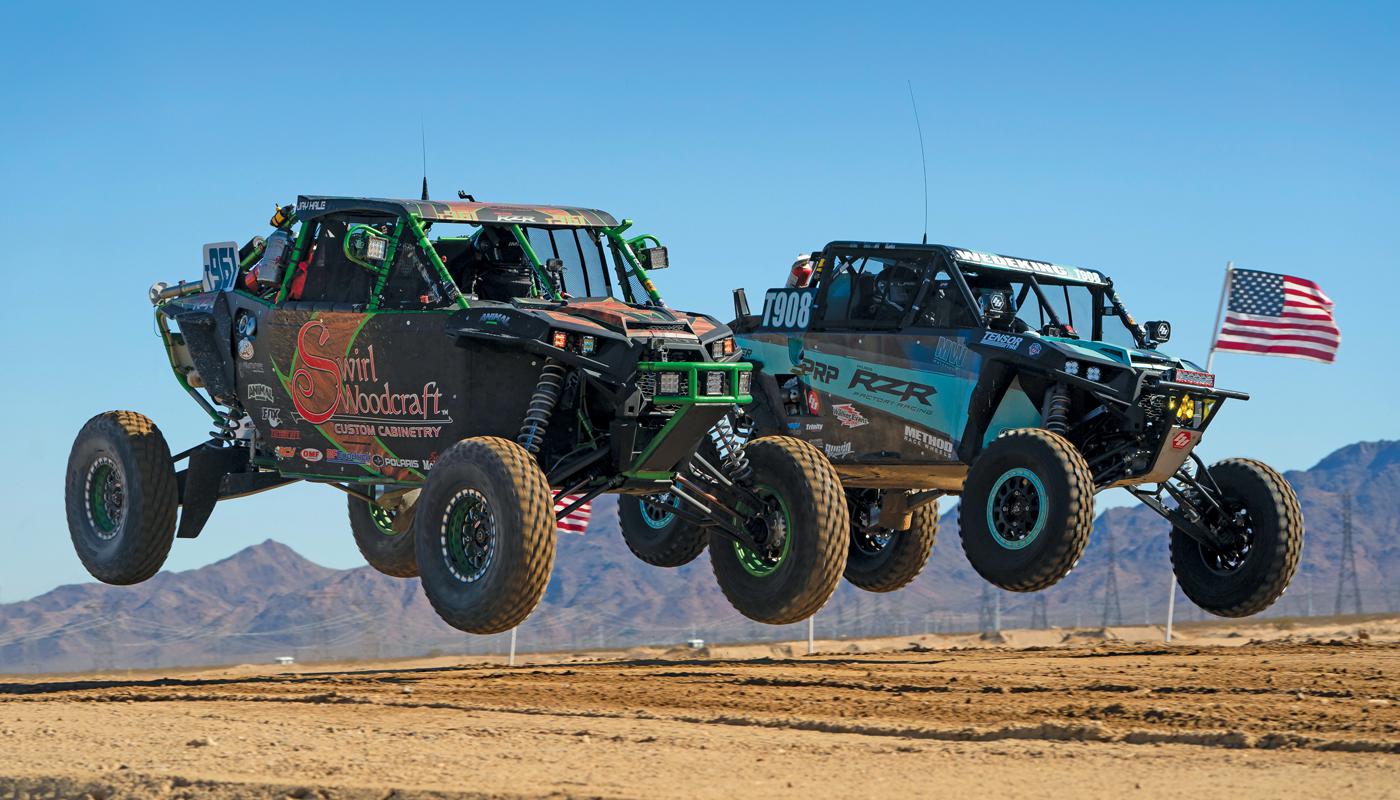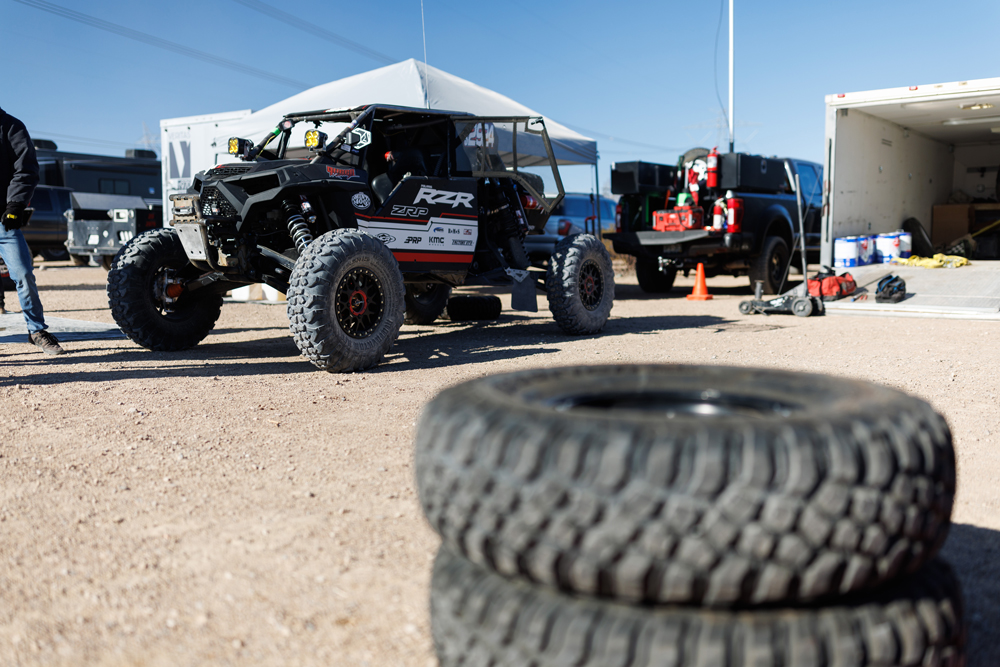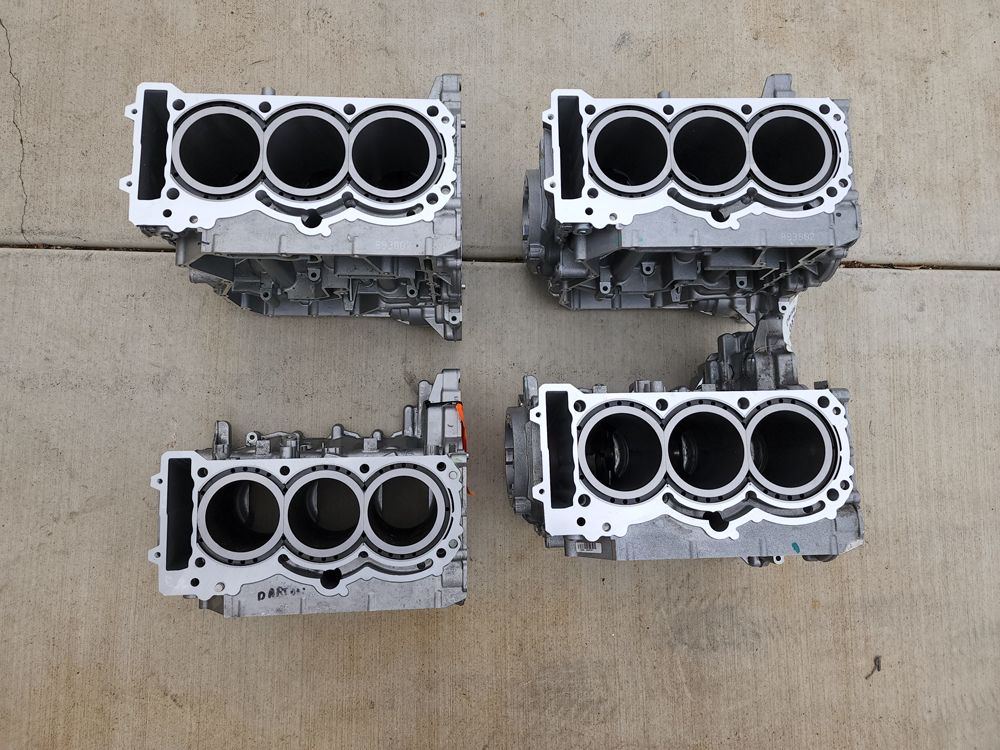Ready To Rumble

Thanks to their impressive capability and surprising affordability, UTVs have taken the off-road world by storm in recent years. Still, racers are discovering weak points in factory setups that must be addressed.
Once dismissed as a novelty by seasoned competitors, UTVs have seen unprecedented growth in off-road racing over the past decade. That trend shows no signs of slowing down.
“The entire segment has just exploded,” explained Matt Martelli of UTV World Championship, Vista, California. “At this point it’s the biggest segment in off-road racing, and for us the entry-level classes are the biggest area of growth right now. What we tend to see is that people come in, race in that class, and they start finding the areas of the platform that could be improved. And they want to move up.”
The out-of-the-box capability of UTVs has played a major role in the vehicles’ ongoing popularity, but there’s another factor that has also played a crucial role in this segment’s rise to prominence. “Prior to UTVs coming onto the scene, you would have needed to go to a race car builder, or buy an existing race car, in order to get involved,” Martelli noted. “Those would all have been up-front hard costs. But UTVs can be financed, and now we’re also seeing participants financing upgrades and modifications as well. So you could literally go racing without being a dime out of pocket before you get on the track.”

With strong aftermarket support, the segment is changing the landscape of off-road racing at all levels. “It’s become an incredibly competitive platform,” said Ricky Berry of RCV Performance Products, Rockford, Illinois. “We’re seeing UTVs with finishing times in desert races that are on par with Trophy Trucks. It’s ridiculous, especially when you consider the cost differences. There was an event earlier this year where a racer in a Polaris Pro R finished in the top three overall in a field that included Class 1 cars.”
Whether a competitor is just getting started in UTV racing or is looking to climb the ranks to the upper levels of the sport, these vehicles require preparation and modification in order to be eligible to compete, run competitively, and last for the duration of an event. Here we’ll take a closer look at what’s being done to get these machines race-ready.
Up and Running
“It’s interesting, we often sell the same products to the guy who’s going out to race for his first time ever as we do to the guys who have factory sponsorship,” said Berry. “But safety is always going to be the first step regardless of what level someone is competing.”
That typically includes the usual suspects—roll cage, racing harnesses, and driver safety gear like fire suits and helmets—but the requirements are largely dependent on the sanctioning body and the class that the vehicle is campaigned in.
“Some classes don’t even require changing out the factory cage,” he pointed out. “But you’re still going to need harnesses, maybe different seats, and you’ll likely need a HANS device for your helmet. Head-and-neck restraints are required pretty much everywhere.”
Dialing In Durability
Larry Heidler, SXS/UTV technical inspector for WORCS UTV in Lake Havasu City, Arizona, pointed out that while factory UTVs are more capable than ever, they are typically outfitted for enthusiasts who hit the trails on the weekends rather than those who’re looking to go racing. “A bone-stock UTV typically isn’t ready for the racing environment,” he said. “You might have something that’s factory-equipped with Fox shocks and stuff like that, but it’s not going to be designed to handle this level of abuse.”
With that in mind, wheels and tires are generally the first things to go. “Beadlock wheels are a common upgrade here,” said Martelli. “There’s some debate about whether that’s necessary on such a light vehicle, but we like that technology because of the forces that the wheels are being subjected to in off-road racing while cornering. UTVs typically weigh between 2,500 and 3,000 pounds, but when you’re throwing one of these vehicles into a corner at speed, all of the weight is going to one wheel, and you want to be sure that you’re not going to peel the tire off.”
Martelli also pointed to strength as another important attribute of a race-ready wheel. “Most of the stock UTV wheels you come across are cast aluminum,” he said. “I wouldn’t say they’re fragile, but they’re not something that you’d want to rely on for a race, so forged wheels are a popular upgrade. And one-piece designs are generally preferable.”
Berry told us that tire choice often comes down to personal preference, but the general consensus is to go big. “Some classes limit tire size to around 32 or 33 inches, but in situations where size isn’t restricted, UTV tire sizes are getting pretty wild. Thirty-five-inch tires are the new normal, and we’re seeing 37-inch tires on UTVs becoming more and more commonplace.”
Chassis and suspension components are usually the next area of focus when it comes to modification. “Factory suspension tunes are usually general purpose,” said Martelli. “But that’s normally going to be a bit soft for racing use. While they might have progressive spring rates, they aren’t using rates that are set up for this kind of application. And the shock tune is hugely important as well. Just like in pavement racing, car setup is key. But here we have a lot more variables to deal with.”
Heidler said that an increasing number of entry-level racers are swapping out the factory A-arms and trailing arms for stronger aftermarket pieces as well. “Those have been found to be weak points, so that’s becoming a more popular upgrade even in the youth classes. A lot of it comes down to the material—the factory component might be made of some sort of mild steel, while the aftermarket options are usually chromoly.”
Berry quipped that you can almost bend some of these factory components over your knee. “It’s designed to be ‘good enough.’ Fortunately, there are now loads of options out there for racers who’re looking for increased strength, whether it be different materials, thicker materials, or just a completely different design versus the stock part. HCR Racing, for instance, offers an arm design that doesn’t use tubes. Instead, it’s a plate design with internal structure, they use chromoly steel, and it’s all TIG-welded. Then you have options like what Lone Star Racing offers, which looks aesthetically like the factory piece but offers far greater strength.”
He told us that axles have also been identified as another common failure point, and that’s largely by design. “Axles are one of the biggest weak links in UTVs. There’s a sense that the factory would prefer these to fail rather than the transmission or differential because the latter are much more expensive warranty items. That failure point is so low that these racers are reaching it pretty quickly.”
Competitors are responding by moving to more robust axle designs that can handle the abuse, along with associated parts that can further bolster longevity. “For us, it’s both the material quality and the engineering behind it,” continued Berry. “There are design limitations because you’re working within the constraints of the factory packaging, but we’re using chromoly housings and 300M steel for the shaft and internals. 300M is just about the best material you can find in terms of memory and fatigue resistance.”
Berry also cited CV boots as another common problem area. “A torn boot is the Achilles heel of a UTV,” he said. “Once you tear that rubber boot, it has the potential to take out the CV and eventually the axle, and now you’re down a corner. So we’ve learned that the grease used is really important. We had guys finish 500-mile races without CV boots because of the grease we developed. As it gets hot, low-end grease will liquefy and follow the path of least resistance, and that means your lubrication is going away from where you need it. A high-end grease is going to be more resistant to liquefaction, and that helps keep it where it needs to be to prevent those failures.”
Turning to the powertrain, Steve Demirjian of Race Engine Development in Oceanside, California, said that there are some very simple upgrades that can have a substantial impact on engine durability. “More power means more heat, so the cooling system needs to run as efficiently as possible. If you’re running a lot of boost on a wet liner the water can cavitate, and you can actually end up eroding the outer surface of the sleeve. So running something like Evans Coolant, which is cavitation resistant, is a good idea.”
The belts on UTV continuously variable transmissions are also a notorious failure point, but solutions have been developed to address that as well. “Clutching is really important here because you’re trying to squeeze as much as you can out of the top end without sacrificing belt life,” said Berry. “But it’s also about airflow to that belt, so bigger air intakes and ducting are important, too. And a belt box fan can also make a big difference. You need to keep the belt as cool as possible in order to extend its life, so that system is pulling in cool air and pushing out hot air to help manage the heat.”
Proper Performance
While durability tends to be the top priority for endurance-style UTV racing formats, short-course and hill-climb events allow racers to prioritize things differently. “In desert racing, most racers leave the motors pretty close to stock,” Heidler said. “But on the short course, those engines are being rung out. Those racers are trying to get every last ounce of horsepower that they can from them because everyone else in the field is doing the same.”
That kind of approach probably isn’t going to last in a 300- or 400-mile race, but the short-course racing tends to be less abusive just by virtue of the format. “A track car is going to be lighter because you don’t need to bring spares with you, and you’re on a groomed track rather than the really varied terrain that you see in desert racing,” said Martelli. “So you can push the setup a bit harder here because durability is less of a concern. If the engine only needs to last half an hour, you can build a high-strung time bomb if you want to.”
Demirjian said that many racers opt to go that route. “People are getting ridiculous power out of these motors. They’re not long-distance combinations. We’re seeing people get 500 or 600 horsepower out of two-cylinder engines. It’s crazy.”
Turbocharging has become an integral part of these high-horsepower engine combinations, and that typically necessitates upgraded rotating assembly components. “So a set of pistons, and the crankshafts that are used in these engines, tend to be a weak point as well,” he added. “Some people are running upwards of 90 pounds of boost on these engines. It’s incredible.”
In order to make a UTV engine live at those boost levels, Demirjian offered a few recommendations. “The cheapest upgrade for these blocks is a dry liner. That will beef them up substantially,” he explained. “If you’re going to run a lot of boost, the Darton MID sleeve is the way to go. It’s far stronger than the factory cylinder wall, so you’re not going to break it. And ARP head studs are basically a requirement in order to get the clamping force needed to keep the head down.”

Heidler also said that tuning plays a critical role in these turbocharged setups. “We spent a lot of time just dyno testing the car and making sure that we can get every last bit of power out of it while still making sure that it’s not detonating, and the fuel mixture is right where it needs to be all the time. In the class I compete in, the races are 55 minutes long, and we’re basically running the engine flat out the entire time. Back in the day you could sit back a little and wait for other competitors’ cars to fail, but now we’re going nonstop from green flag to checkered because the field is getting much more reliable in general.”
On the suspension side, Martelli noted that electronically controlled shocks are becoming an increasingly common sight in UTV racing. “Fox Live Valve shocks have been a game-changer here because they allow for so much greater control over the vehicle’s dynamic behavior. This technology is only a few years old in this market, so we’ve just scratched the surface of what it’s capable of in this type of application.”
Looking ahead, all seem to agree that UTV racing is headed for increasingly sophisticated setups. “We’re at a point now where 600 horsepower is the ceiling,” Demirjian said. “Two hundred horsepower per cylinder on a 900cc engine is a lot. Eventually we’re going to need billet engine blocks, and I think it’s just a matter of time before someone steps up to offer that.”
As the performance bar continues to rise, Berry expects UTVs to push further into the forefront of off-road racing in coming years. “The future of UTV racing is going to be at 100 mph and beyond. I think that’s going to be the norm sooner rather than later.”
With bigger players getting involved in aftermarket development, that prediction seems likely. “Over the past eight years or so, this has become a fairly robust industry,” Martelli said. “The popularity of the segment has started to attract the attention of larger manufacturers. This is just the tip of the iceberg, though. The biggest challenge for everyone right now is just keeping up with the demand.”
Sources
Race Engine Development
raceenginedevelopment.com
RCV Performance Products
rcvperformance.com
UTV World Championship
utvworldchampionship.com
WORCS
worcsracing.com
 MEMBERSHIP LOGIN
MEMBERSHIP LOGIN JOIN PRI
JOIN PRI


